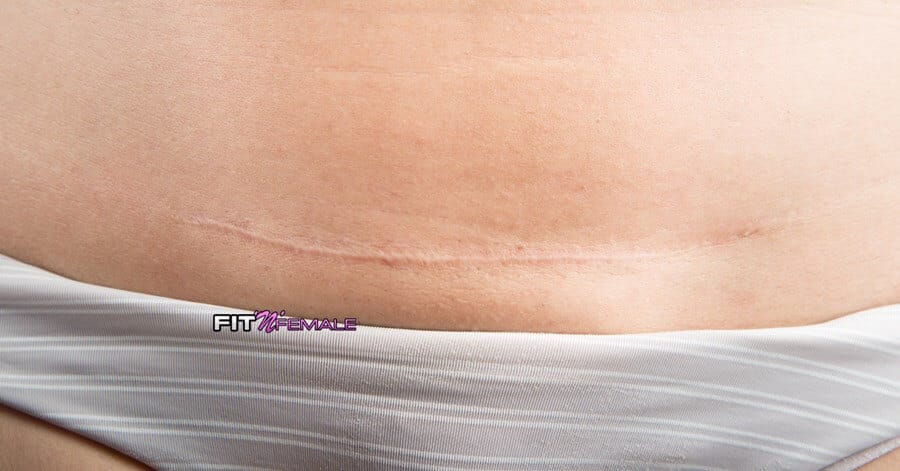About the Caesarean section can be an unmarried affair. Thanks to the latest surgical techniques, the operation itself and the scar that remains later play an increasingly minor role. What is unpleasant is the sometimes enormous lack of information on the subject and the inadequate resources for post-operative care.
If you are lucky, you will be told that you should not lift anything heavy, drive a car or exercise for the first six weeks after the caesarean section. Is that all? What about physiotherapy, emergency instructions and advice on special exercises? You need more information. Just saying "all the best" when you are discharged from hospital is not enough.
What happens during the procedure?
A caesarean section can be planned (e.g. for a breech presentation) or unplanned (e.g. for complications during the birth). In either case, the doctor first cuts through the skin, fat cells, connective tissue and parts of the abdominal cavity. The abdominal muscles are then pushed apart and incised if necessary. As the bladder blocks access to the uterus, it is pushed downwards. The doctor opens the uterus with as small an incision as possible in order to remove the baby and, a little later, the placenta.
Once the baby is born, you will be "closed" again. The uterus, abdominal muscles, abdominal muscles and skin are sutured in reverse order. Self-dissolving stitches hold the injured areas in several layers. As the healing process progresses, scars develop on many levels.
Cured in six weeks?
Not so fast. As mentioned above, a caesarean section is anything but a gentle procedure. It's not just your skin that is cut open. The doctor moves organs, opens the abdominal cavity and much more. Sufficient rest and recovery are essential. You need to be patient and listen to your body. If you start doing sports or lifting heavy things too soon, it can have serious consequences for your whole life. Don't be in a hurry. Give your body the time it needs to heal the wounds completely.
You know best how quickly or slowly an injury normally heals in your case. With a caesarean section, the process will most likely be similar. However, this is not a guarantee.
In general, you can compare this operation with a more complicated knee operation, which has a recovery period of nine to twelve months. Ask your surgeon to draw up a plan for you, which you can then refine with your physiotherapist. You need a timetable so that you can safely return to your previous activities. This is the only way a caesarean section should be treated post-operatively.
Appearances can be deceptive: Healthy on the outside, but not yet on the inside
Below you will be shown how to cope with the special aspects of returning to everyday life after a caesarean section. Always remember that the healing process will not be complete after six weeks. The skin is less demanding and regenerates the fastest. From the outside, the wound will look "healed" much sooner. But in the deeper layers, your body needs more time to scar the tissue there.
If your doctor assures you that you can return to sport after six weeks, these are light and gentle movements. In plain language, this means doing exercises like the following:
- Breathing exercises
- Hiking
- moderate swimming
- Light strength training with your own body weight
- Strengthening the core (e.g. briefly holding a push-up position (a few seconds at first, more later))
However, you should avoid these types of movements:
- Running and jumping in all imaginable forms
- heavy strength training
- Abdominal muscle exercises of any kind (leg lifts, crunches, sit-ups, etc.)
Can caesarean sections prevent pelvic floor dysfunction?
The risk is certainly higher in the period following a vaginal birth. Basically, every pregnancy increases the risk of pelvic floor dysfunction. Either way, you need to regenerate your core, which includes integration and interaction with the pelvic area.
Here are some reasons why you should pay attention to the health of your pelvic floor after a caesarean section:
- The downward pressure of the baby can overstretch the muscles and connective tissue in the pelvic floor. As a result, they will be looser than normal. Special treatment or strengthening of the area is almost always essential.
- The uterus, which has grown considerably during pregnancy, presses increasingly harder against the pelvic organs (bladder, rectum, etc.), which can disrupt their natural function.
- The scars after a caesarean section can disrupt the function of the nerves in the pelvic floor. A burning sensation in the urethra, pain in the genital area (clitoris and labia) or a constant urge to urinate are often the result.
- During pregnancy, you change the way you stand and walk. You sit differently and don't do other things the way you normally do. Everything is geared towards taking it easy. This makes sense, but for the muscles in the pelvic floor area this can mean that they become tighter and shorter over time.
Recovery in the first few weeks after the birth
In the early days, you will rest and relax as much as possible and concentrate fully on the baby. There are a few things you can do in the first six weeks after your C-section. Here are the most important of them:
1. request for help
Get help from your partner as well as your family and friends. They will all want to give you a helping hand. Don't be piqued if they make exaggerated offers. Instead, be happy about their care. Because even if the healing meat doesn't cause any discomfort, any effort could have bad consequences. Your only job should be to settle into your new role and literally mother the baby.
2. sideways from the lying position to the sitting position
You must avoid any pressure on the abdominal area. First lie on your side when you want to sit down. You can "roll up" from this position. If you were to stand up frontally as usual, this would put a lot of pressure on your injured abdominal area.
3. restful breathing
Start restoring your core immediately or in the first few days after giving birth. By breathing deeply from the abdomen, you strengthen a large part of the area from the diaphragm to the pelvic muscles. Feel the gentle expansion of your chest and abdomen as you inhale. As you exhale, you will feel the abdominal muscles and pelvic floor being activated in the same way.
It makes sense to do this abdominal breathing before any exertion and to start after exhaling. This also applies if you want to hold your baby in your arms.
4. walk
You should stay in bed at first. As long as the wounds are still fresh, every step is one too many. Once the healing process has noticeably begun, you should start moving slowly. Start with a few steps. Increase the number steadily, for example by walking around your house. Listen to your body and feel how the energy returns. Continue to do your breathing exercises during your short walks.
5. go to a physiotherapist for pelvic floor training
Within the first six weeks after the birth, you should ask your doctor to prescribe you a pelvic floor treatment with a physiotherapist, even if you have no complaints. During physiotherapy, the specialists can determine the correct functionality of your pelvic area and start mobilizing your surgical scar.
Depending on the healing process, you could start practicing core stability exercises in addition to your breathing routines before the 6-week check-up. There is no magic date for when you can start again. Every body heals differently. The physio experts will be able to provide you with crucial help by performing the following exercises with you, among others:
- Glute bridges or pelvic lifts from the supine position
- Lateral thigh raises with bent legs (clamshells)
- Stretch your legs from a supine position (bend your legs and alternately bring them parallel to the floor)
You can use your core breathing during all of these exercises. It is best to exhale immediately before doing the difficult parts.
Resumption of strength training after the caesarean section
After the six-week initial regeneration, including a final check-up by your physiotherapist, you can in consultation with your doctor start your traditional strength training. Give your body enough time to process the increasing demands of the movements. Above all, this includes sufficient recovery between exercises.
It is best to start with two 15-minute training sessions a week, which you can slowly increase. A good guideline would be to increase the duration by 5 minutes every 14 days. Many women set themselves the goal of exercising four times a week for 30 to 40 minutes. If your circumstances allow, you can use this as a guide.
At the beginning of your reintroduction phase, you should train with your body weight and light dumbbells. Expanders, resistance bands and TRX exercises are ideal. Heavier weights are loads that you should only put your body through once the wounds in all layers have healed as completely as possible. Here are some examples of useful exercises:
- Modified side lift (body lift from lateral position; lower leg bent)
- Squats without dumbbells (with body weight only)
- Lunges (don't go down too far at the beginning)
- Shoulder pull with the expander (grasp the strap (not the handle) shoulder-width in front of the body and pull outwards
Here too, you can integrate core breathing into each exercise by exhaling just before the difficult phase and taking a breath as you return.
Two points are very important here:
1. just as with pelvic floor training, you should focus on the second, less strenuous part.
Only if you perform the entire movement sequence of the exercises with the same intensity can the workouts develop their optimal effect. This also helps you to avoid technical errors that can lead to injuries.
2. your body must be in a neutral alignment for all exercises. This means that your back and spine should form a long, straight line. Slight curves are useful in the lumbar region and at the base of the neck. Make sure you keep your chest as vertical as possible above your pelvis.
Exercises you should avoid after a caesarean section
Any kind of exertion that puts direct pressure on your pelvic floor is taboo for the time being. Here is a short list of exercises that you should avoid until your scars have completely healed:
- General: Training with heavy weights
- Crunches, sit-ups and all other abdominal exercises
- Leg lift (exception: modified leg lift (see above)
- Body position in the push-up position ("front planks")
- Endurance run
- Jumping
- Step training ("step ups")
- Heavy overhead lifting with dumbbells ("snatching")
- all exercises with direct pressure on the pelvic floor (e.g. squats with barbell in the neck)
Resuming exercise is very similar after a caesarean section and after a vaginal birth. The main thing is to feel your body before, during and after exercise. It is also important to exercise in such a way that you feel safe, energized and good at every stage of the sessions.




